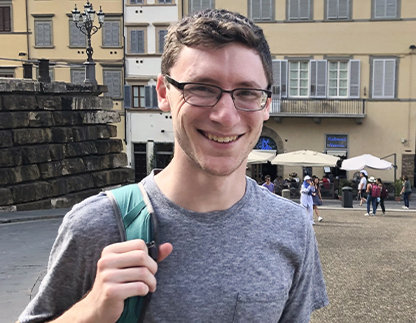I hope my research will shed new light on the ways that people use visual art to conceptualize the cities they live in and the communities they belong to.”
Ben Weil
PhD Candidate in the Department of Art History

Ben Weil is a PhD candidate in the Department of Art History in the Weinberg College of Arts and Sciences. His research focuses on medieval art, particularly on the representations of cities in fourteenth-century Italy. He seeks to understand the relationship between individuals’ art and their civic identities in the Middle Ages. Ben is a Mellon Cluster Fellow in the Medieval Studies Cluster and will be a Graduate Writing Fellow at The Writing Place in the 2024–25 academic year.
How would you describe your research and/or work to a non-academic audience?
I study images of cities produced in Italy in the fourteenth century. In the years after the Black Death, representations of cities appeared in painting, sculpture, manuscript illumination, and even minted on coins. I am fascinated by what these images can tell us about the ways that people conceptualized the places they inhabited at the end of the Middle Ages. Elite patrons used these images as political tools to foster civic identity and define the boundaries of their communities. However, citizens did not always agree with the ideas about their cities that these images presented, and I investigate the place of city images in contemporary debates about civic identity and belonging.
Tell us what inspired your research and/or work.
Since I took my first art history course in college, I’ve been excited to learn about people and their conceptions of the world around them through the physical things that they make. I became especially interested in mapmaking and the representation of cities in the Middle Ages, since these images were produced before the invention of modern surveying technologies, making it a period of experimentation in the representation of place and space. I grew up with strong civic pride for my hometown, Minneapolis, and wanted to learn how people historically identified with the places they inhabited. I also wanted to understand the ways the definition of a civic community could include, exclude, and erase.
What do you find both rewarding and challenging about your research and/or work?
The biggest challenge in conducting my research has been learning the languages of fourteenth-century Italy so I can read the archival documents that detail the production of city images and the ways viewers responded. Even after training in Medieval Latin, Italian, and paleography (the study of old handwriting), reading archival documents continues to be a challenge. But puzzling out abbreviated words and idiosyncratic handwriting to read accounts from over 600 years ago is incredibly rewarding.
What is the biggest potential impact or implication of your work?
Art historians have often studied medieval city images for their topographic accuracy or as precursors to renaissance methods of representing space. My research shows that these images had political significance and were used as arguments in contemporary debates about who belonged in civic communities. Previous studies of civic identity often focus on literary texts and elite humanist authors and politicians, but since city images appeared in prominent locations and circulated on everyday objects like coins, they can reveal the responses of a broader range of society. I hope my research will shed new light on the ways that people use visual art to conceptualize the cities they live in and the communities they belong to.
How do you unwind after a long day?
After spending the day reading and writing I feel the need to move around. I play on a soccer team and this year I’ve gotten into rock climbing. I also love exploring Chicago by bike.
What books are on your bedside table?
Right now, I am reading Moonbound, a science fiction novel by one of my favorite authors, Robin Sloan. I just finished Eileen by Ottessa Moshfegh.
For my research, I’m currently reading a medieval account of the life of Saint Fina, an Italian saint who is often represented holding a model of her city, San Gimignano. Fina became paralyzed as a young girl, and when she died her wounds transformed into flowers and she began to miraculously heal visitors to her tomb. I’d recommend it to anyone who is looking for morbid descriptions of medieval diseases.
Tell us about a current achievement or something you're working on that excites you.
This spring I participated in a workshop titled “Beyond the Medieval Archive” at the Newberry Library in Chicago. In the workshop a group of medievalists explored the way our research skills in medieval archives can be applied to contemporary problems, such as helping indigenous tribes produce archival documentation for federal recognition. We are currently preparing our reflections on the workshop for publication, and I’m excited to continue with this type of work in the future.
Publish Date: August 13, 2024
If you know a graduate student, postdoctoral scholar, graduate faculty member, staff member, or a member of our TGS alumni population who would make a great candidate for our TGS Spotlight Series, please complete this brief TGS Spotlight Series Nomination Form.